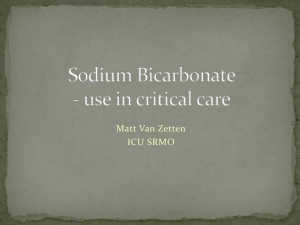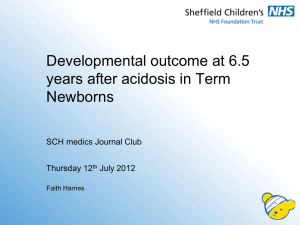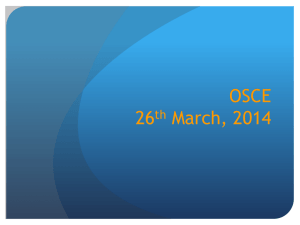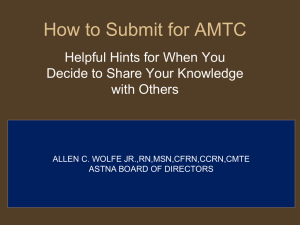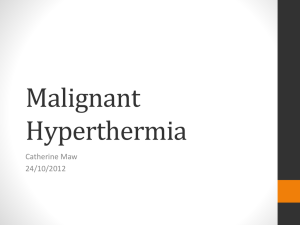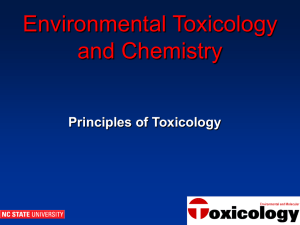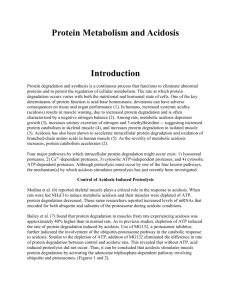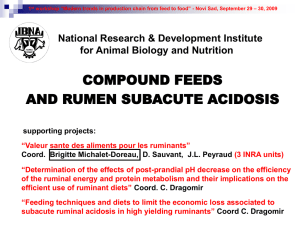Inservice Review: Toxicology
advertisement
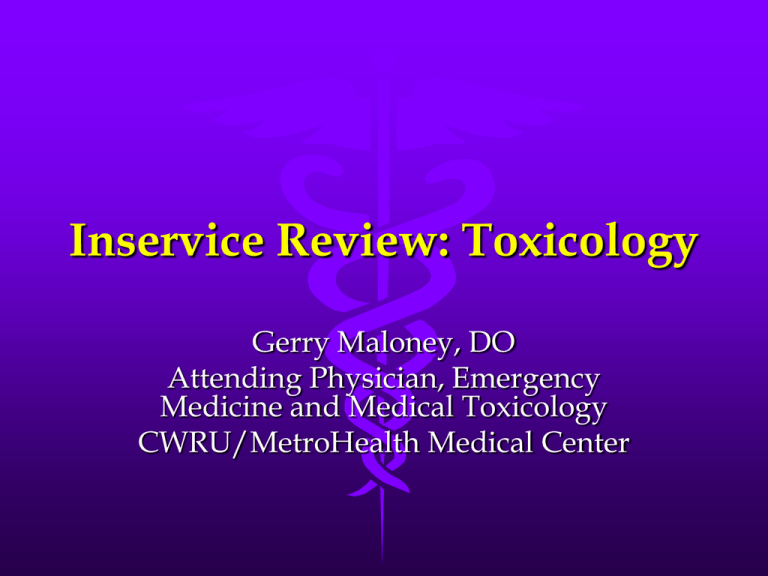
Inservice Review: Toxicology Gerry Maloney, DO Attending Physician, Emergency Medicine and Medical Toxicology CWRU/MetroHealth Medical Center Analgesics • APAP • 140 mg/kg toxic dose for single acute ingestion (200 mg/kg peds) • Rumack-Mathews nomogram only for single acute ingestion • NAC can be given with charcoal (no need to adjust dose) • PO NAC: 140 mg/kg load, then 70 mg/kg q 4 h for 72 h • IV NAC: 150 mg/kg LD, then 50 mg/kg over 4 h, then 100 mg /kg over 16 h • APAP • Liver injury usually takes 24 h to develop for acute OD • Elevated AST & detectable APAP treat with NAC • Refer for transfer: elevated INR, encephalopathy, acidosis, renal failure Analgesics • ASA • Toxic dose 140 mg/kg • See respiratory alkalosis first, then mixed metabolic acidosis/resp alkalosis • Cause of AGMA • Treatment is IV bicarb • HD for: level > 60 chronic or > 90 acute, esp if mental status changes Opiates • Heroin: short-acting • Methadone: long-acting • Narcan: lasts approx 25-45 min • Can see seizures from demerol/propoxyphene • Wide QRS and hypotension with propoxyphene • Pulmonary edema can be seen with all Alcohols • EtOH: zero-order kinetics • IsoOH: osmole gap, may be serum/urine ketones, gastritis, no metabolic acidosis • MeOH: blindness, severe acidosis; windshield-washer fluid • Ethylene Glycol: antifreeze; Ca Ox crystals in urine, flourescent urine; renal failure, metabolic acidosis • If double gap (osmole and anion) is present, think MeOH or EG • MeOH/EG treated with IV EtOH or fomepizole; hemodialysis for acidosis, levels > 25 mg/dL • Anion: Na-Cl + HCO3; Osmole: 2(Na) + BUN/2.8 + Glu/18 + EtOH/4.6 Anesthetics • Know the dose and effects of your procedural sedation drugs (versed, ketamine, fentanyl, propofol) and when not to use them • Classic question is lidocaine allergic pt who need local anesthesia; what can you use? • Lidocaine is an amide; amides have 2 i’s • So look for the answer with one i, or can also use benadryl Autonomic Agents • Know cholinergic, anticholinergic, sympathomimetic toxidromes • Cholinesterase inhibitors (OP agents, nerve agents) • Treatment is atropine 1st (endpoint is secretions, not heart rate or atropine dose) • Then 2-PAM (to prevent aging, ie irreversible binding of OP to cholinesterase enzyme) • DUMBELS is mnemonic Autonomic Agents • Anticholinergic • Dry skin/mouth or decreased bowel sound is clue • Treatment is benzo first; can consider physostigmine (though NOT if tricyclic on board) • Jimson weed or benadryl are classic agents Autonomic Agents • Sympathomimetics • HTN, tachy, dilated pupils, moist skin • Cocaine can cause Na channel blockade and wide QRS • Treatment for all sympathomimetics is lots of benzos • Avoid β blockers in cocaine • Ecstasy-see bruxism and hyponatremia Anticoagulants • Most children with rat poison (brodifacoum) asymptomatic • FFP is first-line for severe bleeding • IV vitamin K is associated with allergic reactions • Make sure you give K1 (activated vit K) Anticonvulsants • Dilantin • Iv infusion: hypotension (from propylene glycol) that is rate-related, necrosis if IV infiltrates • PO: OD sees ataxia/nystagmus, may be obtunded late • Normal level is 10-20 • Load is 17 mg/kg IV Anticonvulsants • Carbamazepine • • • • Level is 4-12 Has active metabolite that is also toxic (10,11 epoxide) Can cause seizure in OD, cross react with TCA on urine tox Treat with multi-dose AC • VPA • • • • Hyperammonemia in absence of toxic level or abnl LFT Need serial levels in OD (irregular absoprtion) Normal is 50-100 Can use MDAC, hemodialysis (level >1000) or carnitine Antidepressants • TCA: hypotension, seizure, anticholinergic sx; wide QRS on EKG (look at aVR); treat with bicarb • QRS > 120 predicts increased risk of szr • Trazodone: priapism, orthostatic hypotension • Buproprion: wide QRS, seizure, SND reuptake • Citalopram: cardiotoxic • SSRI or MAOI think serotonin syndrome, may be delayed if MAOI involved Antipsychotics • Can see QT prolongation and orthostatic hypotension with all • EPS/akathisia decreased with use of benadryl/cogentin • NMS vs SS: NMS has slow onset, lead pipe rigidity, hyperthermia; SS rapid onset, reflexes and muscle tone LE>UE • Stop offending agent, benzos, may consider cyproheptadine (SS) or dantrolene (NMS) CO • Know half life of CO (RA 3-4 h, 100% 90 min, HBO 23 minutes) • Know classic presentation (HA, vomiting, winter, whole family sick) • Refer for HBO: level > 40% (15% if pregnant), syncope, MI, mental status change, neuro deficits • CNS lesion: bilat globus pallidus Cardiac Meds • Digoxin • Level > 2 ng potentially toxic • Classic EKG is bidirectional VT or PAT with block • Most common finding is PVC’s • K > 5 serious toxicity • Digibind: empiric treatment is 5-10 vials (acute OD), 3-5 vials (chronic OD) • Can calculate if level is known (dig level x wt in kg/100= # of vials) Cardiac Meds • Beta blockers • Glucagon is antidote • Propranolol causes seizures • CCB • See metabolic acidosis and hyperglycemia (DKA like picture) • Most ER so need prolonged observation • “pill can kill” in kids • Treatment: calcium, pressors, HIE • Clonidine • Looks like opioid, narcan sometimes reverses effects Caustics • No vomiting, no charcoal • Alkali: liquefactive necrosis deeper burn • Acid: coagulation necrosis stops burn • Can have severe esophageal injury w/o intra-oral injury • Steroids not generally helpful CN/HS • CN: rapid BP fluctuations, metabolic acidosis (elevated lactate) • Affects Cytochrome aa3 • Treatment: amyl nitrate/sodium nitrite, then sodium thiosulfate • See “arterialization” of venous blood (high venous O2 sat) • HS: rapid knockdown with rotten egg smell Metals • AC binds poorly to all metals (works for strychnine) • Li: causes ataxia; HD if level > 2.5 (chronic) or 4 (acute); can treat with IVF/WBI • As: see vomiting early, then neuropathy/multi-organ failure/prolonged QT, Mee’s lines • Lead: • • • • level > 70 needs parenteral chelation. Give BAL and EDTA. Peanut allergy is contraindication to BAL. > 10 is action level Herbicides/pesticides/rodenticides • Many are arsenical • Also see superwarfarins or organophosphates • Paraquat: need to decrease FiO2 Hydrocarbons • Determinants of aspiration risk: • Surface tension • Viscosity • Volatility • Never induce vomiting • May see delayed pneumonitis (esp in kids) • Sniffers/huffersmyocardial sensitization to catecholamines, can have sudden death Hypoglycemics • Insulin: not much • Sulfonylurea: prolonged hypoglycemia; octreotide is antidote • May be delayed in kids, generally need 24 hour OBS • Metformin: lactic acidosis, esp in renal failure Inhalational • Water solubility determines toxicity • High-immediate irritation to eyes/MM • Medium (like Cl) some upper and lower airway stuff • Low: all the way into the lungs, delayed pulm edema (phosgene) • Bleach + acids/ammoniachlorine or chloramine gas • CS: riot control agent Iron • See phases (Phase 1: immediate GI sx; phase 2: quiescent; phase 3: acidosis, liver injury, GI bleed; phase 4: recovery) • Know different preps have different amounts (FE fumarate>sulfate>gluconate) • Deferoxamine (DFO)is antidote • Vin rose urine is sign DFO is working INH • Inhibits pyridoxal phosphateprevents creation of GABA • Clinical picture is intractable sz • Causes profound lactic acidosis (“I” in MUDPILES or METALACIDGAP) • Treatment is pyridoxine (1 g of B6 for every G of INH ingested, or 5 g empiric dose) Methemoglobin • Change in oxidation of iron in heme molecule (Fe++ to Fe+++ ) • Chocolate brown coloration of blood • Also the MOA of nitrates in the CN antidote kit • Treatment (if levels >20% or severe sx) is methylene blue 1 mg/kg • High-risk persons include those susceptible to oxidative stress (G6PD) Shrooms/Plants • Shroom you most need to know: amanita phalloides • Delayed GI sx (>4 h) after ingestion is associated with toxic mushrooms (delayed sx bad) • Liver failure is result of A. phalloides • coprinus antabuse reaction • Gyromitra (false or brain morel) intractable sz (INH-like, treated like INH) • Amanita muscaria (red shroom)-anticholinergic • Psilocybin (little brown shroom)-hallucinogen Shrooms/Plants a. phalloides gyromitra coprinus a. muscaria psilocybin Shrooms/Plants • Plants • Cardiac glycosides (yew, oleander, lily of the valley, foxglove) dig-like toxicity • Can treat with digibind • Poison Ivy: 3 shiny leaves; blistering rash; type IV allergic reaction • Jimson weed: anticholinergic • Castor bean: ricin; inhibits RNA, MOSF Shrooms/Plants jimson foxglove ricin Poison ivy Neuroleptics • EPS responds to cogentin/benadryl • Can decrease EPS when giving phenothiazines by pretreating with benadryl • NMS: gradual onset, hyperthermic, AMS, lead pipe rigidity, rhabdo; treat with benzos, +/- dantrolene, stop agent • SS: more rapid onset, similar clinical picture except LE more rigid than UE; consider cyproheptadine Nonprescription drugs • Cough & cold preps • Dextromethorphan: can x-react with PCP on U Tox; see nystagmus and AMS/ataxia • Pseudoephedrine: sympathomimetic, methamphetamine precursor • Vitamins: know Fe content • Imidazolines (afrin): look like clonidine • Oragel: benzocaine, can cause methemoglobin • Lido patches: seizures Recreational Drugs • Cocaine • Sodium channel blockade • Sympathomimetic toxidrome, may see widened QRS • Metabolite in urine: benzoylecgonine • EtOH + coke cocaethylene, which may be more toxic than plain coke • Treat with benzos, avoid β-blockers Recreational Drugs • Heroin-already covered • Ecstasy hyponatremia • GHB: comatose, then wakes up suddenly and yanks out ETT • Ketamine: dissoc anesthetic, emergence reactions, intact airway reflexes • PCP: hallucinations, rotary nystagmus Sedative-hypnotics • Benzos • Dec LOC, generally need to mix with EtOH to have sig toxicity • Rohypnol: ultra rapid metabolizer, does not xreact on standard U Tox • Barbiturates • Skin bullae, coma, hypothermia; can treat phenobarb with MDAC/urinary alkalinization/HD • Soma • Meprobamate, may cause bezoar/radio-opague Strychnine • Increase in excitatory neurotransmission • Pseudo seizure activity (rigid, opisthotonus, awake) • Marked lactic acidosis • Rat poison is culprit Toxicology in the Core Curriculum Environmental Toxicology • Arthropods • Black Widow • Presentation is severe abd cramping mimicking acute abd with normal labs • Key: may have been working in garage/reaching into pile of lumber • Treatment: supportive, may try calcium gluconate; antivenin not generally available • Brown recluse • Small wound that develops into ulcer • Treatment: wound care; dapsone has been advocated before but not used widely d/t risk of MetHb Environmental Toxicology • Scorpions • Centuroides only significantly venomous species in US • Neurotoxin that cause paresthesias/vomiting/cramping, treatment is supportive • Tick • Tick paralysis= neurotoxin by dermocentor sp usually Environmental Toxicology • Marine • Scombroid: large fish (tuna, mahi-mahi, swordfish), excess histamine in flesh; flush/cramping/diarrhea/hypotension • Ciguatera: also larger fish, hot/cold reversal in extremities • Jellyfish: treat with ammonia or urine (not fresh water) • Lionfish: hot water immersion Environmental Toxicology • Snakes • Pit viper: diamond shaped head, pits anterior to eyes, fangs • Crofab: used instead of Wyeth antivenin; less risk of anaphylaxis/serum sickness • Pit vipers (rattlers, cottonmouth, copperhead) have hemotoxin (low plt, coagulopathic) and cause tissue swelling +/- compartment syndrome • Elapids (coral snake, cobras) are neurotoxic • Mojave rattler is only NA pit viper with primary neurotoxin Environmental Toxicology • Snakes Good Luck!


